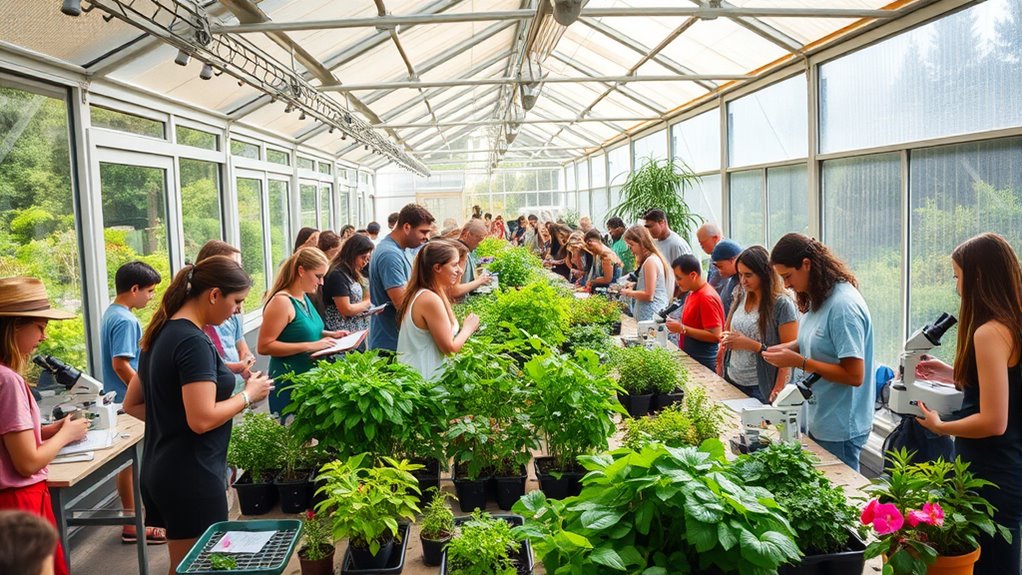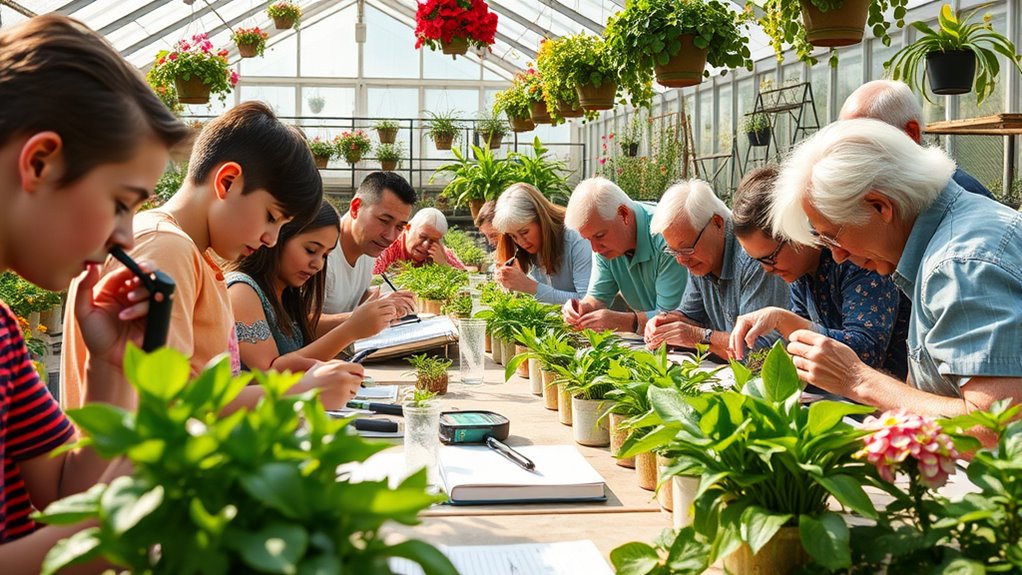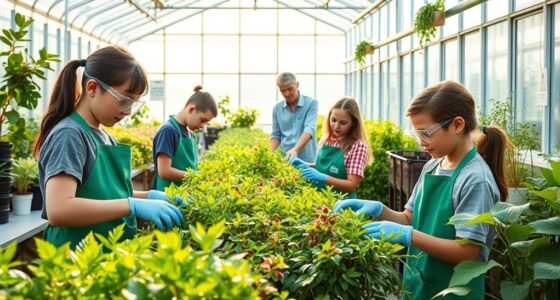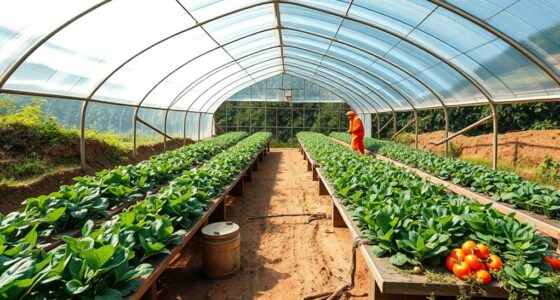Hosting citizen science in your greenhouse invites the community to actively participate in research, making it a vibrant hub for scientific discovery and environmental awareness. You can organize workshops, encourage visitors to collect data on plant growth, pollinators, or climate conditions, and share results through social media. This not only boosts engagement but also supports larger research efforts. If you want to learn how to effectively set up and protect these activities, there’s more to explore.
Key Takeaways
- Organize engaging activities like plant growth observations and pollinator monitoring to actively involve visitors.
- Provide simple data collection tools such as apps or spreadsheets for easy participation.
- Offer training and guidance to ensure accurate data recording and meaningful contributions.
- Promote awareness by sharing findings through social media, signage, and community events.
- Implement security zones to protect sensitive data, equipment, and maintain a safe environment for volunteers.

Have you ever considered turning your greenhouse into a hub for citizen science? By opening your space to community participation, you create an exciting opportunity to foster public engagement and contribute valuable data collection. Citizen science encourages people of all ages and backgrounds to get involved in scientific research, making your greenhouse a vibrant center for learning and discovery. When you invite the public into your greenhouse, you not only help demystify scientific processes but also build a stronger connection between the community and environmental stewardship.
Engaging the public in your greenhouse activities means providing accessible ways for them to contribute directly to ongoing projects. For example, you might organize workshops where visitors learn how to observe plant growth stages, record temperature and humidity levels, or track pollinator visits. These activities turn passive visitors into active participants, fostering a sense of ownership and curiosity. As people collect data, they gain a deeper understanding of plant biology and ecosystems, which enhances their appreciation for sustainable practices. Plus, their collective efforts generate a wealth of data that can support research, track climate impacts, or improve crop management strategies.
Organize workshops to help visitors observe plant growth and track environmental data.
Involving the community in data collection also expands the scope of your projects. Instead of relying solely on your resources, you tap into a diverse pool of volunteers who can gather information over wider areas and extended periods. This crowdsourced data often offers a more comprehensive picture than what individual researchers could achieve alone. It’s essential to guide participants properly, providing clear instructions and training to ensure that the data they collect is accurate and useful. You can use simple tools like apps or spreadsheets that make input straightforward, making the process seamless for everyone involved.
Public engagement through citizen science in your greenhouse can also elevate awareness about environmental issues, such as biodiversity loss or climate change. When people see firsthand how their observations contribute to real scientific outcomes, they develop a stronger sense of purpose and responsibility. Hosting events, creating educational signage, or sharing findings via social media can amplify your impact and inspire ongoing participation. The more people feel connected to the science happening in your greenhouse, the more likely they are to become advocates for sustainable practices and conservation efforts.
Furthermore, integrating Vetted security zones into your greenhouse can help protect sensitive research data and equipment, ensuring a safe environment for both volunteers and valuable scientific assets.
Frequently Asked Questions
How Can I Attract Diverse Citizen Scientists to My Greenhouse Project?
You can attract diverse citizen scientists by employing effective outreach strategies like social media campaigns, local events, and school programs. Partner with community organizations, cultural groups, and local businesses to expand your reach. Make participation accessible and engaging, emphasizing the project’s impact. By building strong community partnerships, you create a welcoming environment that encourages people from different backgrounds to get involved and contribute to your greenhouse project.
What Safety Measures Are Necessary for Public Participation in Greenhouse Experiments?
Think of safety measures like a sturdy shield protecting your visitors. You should post clear safety signage to guide participants and highlight hazards. Implement emergency protocols, such as accessible exits and first aid stations, so everyone knows what to do in a crisis. Regularly train staff and volunteers on safety procedures, ensuring a safe environment where citizen scientists can explore and contribute confidently without risk.
How Do I Handle Data Privacy Concerns From Volunteers?
You handle data privacy concerns by implementing consent protocols that clearly explain how volunteers’ data will be used. Always use data anonymization techniques to protect identities. Make sure volunteers understand they can withdraw at any time and that their data remains confidential. Regularly review your data handling policies to stay compliant with privacy laws and foster trust, ensuring volunteers feel safe sharing their information in your greenhouse projects.
What Are the Legal Considerations for Hosting Citizen Science Activities?
When hosting citizen science activities, you need to ensure legal aspects like protecting intellectual property and obtaining liability insurance. Make sure you clarify ownership rights for any data or discoveries and include terms that specify how information can be used. Additionally, securing liability insurance helps cover potential accidents or damages. By addressing these points, you safeguard your project and ensure compliance with legal requirements, creating a safe environment for volunteers.
How Can I Evaluate the Success of My Citizen Science Program?
Think of your citizen science program as a garden; its success blooms through careful evaluation. You evaluate by analyzing data collected and comparing it to your goals, like measuring plant growth. Don’t forget to gather participant feedback, which acts like sunlight encouraging continuous improvement. By regularly reviewing data analysis and listening to your participants, you’ll see how well your project thrives and identify areas for future growth.
Conclusion
Hosting citizen science in your greenhouse not only boosts your understanding of plant growth but also engages the community in meaningful research. Did you know that over 60% of citizen science projects see increased public interest and awareness? By opening your greenhouse doors, you help collect valuable data while inspiring others to explore science firsthand. So, get involved — your greenhouse could be the perfect place to make a real difference and foster a curious, informed community.










